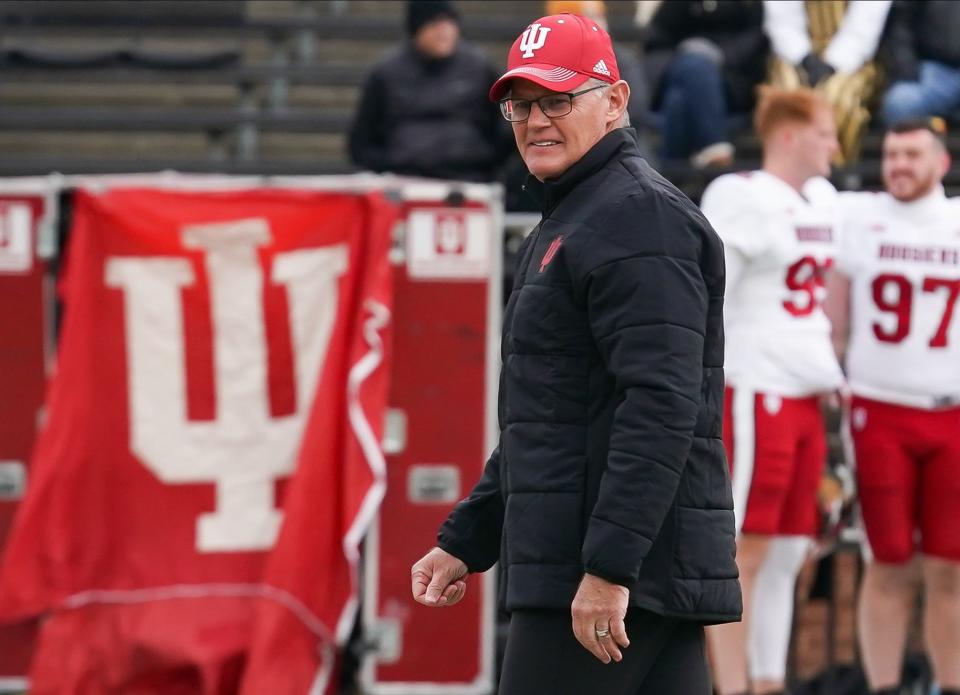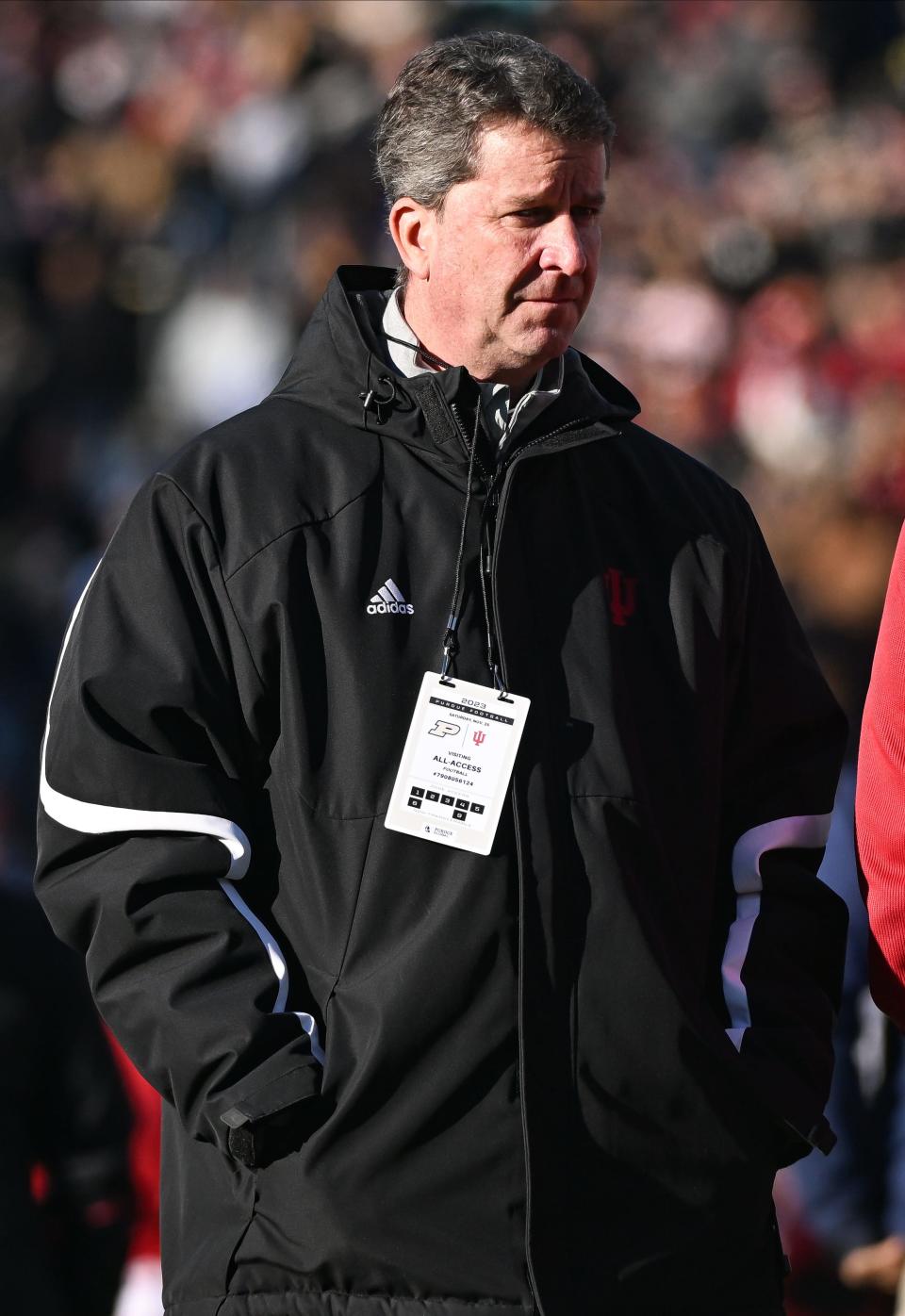IU has poured resources into football. Search for Tom Allen's successor will require more.
BLOOMINGTON – The last time Indiana conducted an open search for a football coach, the south end of Memorial Stadium was still open to 17th Street.
The Hoosiers played in a Big Ten that had yet to introduce the first of what would eventually be two divisional alignments. The Big Ten Network had just come online three years earlier. And when he promised to pay the going rate for a football coach in America’s oldest conference, Fred Glass handed Kevin Wilson a seven-year, $8.4-million deal.
Glass talked then about mimicking Gary Barnett (Northwestern) and Barry Alvarez (Wisconsin). He wanted a patient build toward success, after years of underfunded failure. Now, Glass’ successor must find his own vision for a once-again flailing program, one in need of short-, medium- and long-term vision, all at once.
As Scott Dolson moves on from Tom Allen, he and his administration need to conduct a serious forensic analysis of why Indiana’s most successful football coach in the past 30 years, in the end, failed so fully.

Expect him to move quickly, if he has his way. Indiana entered this search with a clear-eyed idea of the profile of coach it wanted to target. It may not need long to find one.
If IU is turning the page so fully, it’s worth clarifying some misconceptions just to start.
Doyel: IU football vacancy has never looked prettier, but Big Ten has never looked scarier
IU coaching candidates: Who will Indiana turn to replace Tom Allen?
Reaction: Former player challenges administration in wake of coach's firing
First, Tom Allen did not succeed because he simply rode Kevin Wilson’s coattails. Allen’s defensive turnaround was central in delivering a second bowl berth in as many seasons in 2016, and his staff and roster had largely turned over by the time Indiana reached the Gator Bowl — Allen’s first as head coach — following the 2019 season.
Even players Allen theoretically inherited, like Peyton Ramsey and Bryant Fitzgerald, were developed under and enjoyed most or all of their best football in Bloomington playing for the former Ben Davis coach. Much, if not most, of Allen’s success in Bloomington was a result of work he helped organize and execute.
If Allen deserves criticism for all that eventually went wrong during the past three years of his tenure, he also deserves credit for the undeniable success of the first four. Don’t lose sight of that, for reasons we’ll discuss in a minute.
Second, Indiana has increased spending on football, substantially.
The department paid Allen more than twice as much per year as it ever paid Wilson, who throughout his entire tenure had been IU’s highest-paid football coach ever. Routinely, Indiana empowered Allen to hand out program-record contracts for assistants and coordinators. In 2022, Indiana reported more than $31.8 million in football-specific operating expenses on its annual NCAA financial report, an increase of nearly $15.7 million from a decade earlier.
Since Glass’ tenure began, both ends of Memorial Stadium have been enclosed, Indiana has secured funding to dramatically renovate its locker room and team facilities, and just this summer IU announced it would be creating a football-specific strength training space inside the North End Zone.
Not only did Indiana pay Allen more than it paid either Archie Miller or Mike Woodson by the time it reworked his contract in early 2021, it might also have just paid more than $23 million due across either the next seven months or the next four years to fire both him and his staff.
And for all that, in that time, Indiana has gotten four bowl berths, two winning seasons, no bowl victories and five wins against Purdue.
The problem has not been that IU doesn’t spend on football. It has been that that spending has too inconsistently impacted results.
This is the question Dolson must confront as he searches for Allen’s replacement.
His department has poured significant resources into football. It has not spent every dime it had, but Sunday’s buyout decision hardly reflects a program living within its means either.

By any measure, the past 13 years have been more fruitful than the previous 15. There have been more Big Ten wins, more upsets, more postseason appearances and much more parity with conference rivals.
Yet the Hoosiers have also plateaued in some glaring ways, Allen’s three-year dip leading to his firing the latest and perhaps pronounced example. Name, image and likeness rules have changed the calculus for achieving — and sustaining — success in modern college football. The Big Ten is about to add four powerhouse programs from the Pac-12, making the road to bowl eligibility even steeper for programs with fewer resources and less established tradition.
Future developments, primarily the ability for athletic departments to use funds for NIL purposes (something Allen publicly supported), could benefit Indiana. But College Football Playoff expansion and further conference consolidation could also threaten what gains the Hoosiers make, as the sport’s rich-get-richer trends only continue to intensify.
Which leaves Dolson holding a mixed bag.
Indiana has some appeal as a job. It has demonstrated it will commit to competitive compensation for both its head coach and his staff. Its facilities have dramatically improved in the past 7-10 years. Big Ten money won’t stop flowing any time soon, and IU enjoys protection from the turbulence of conference consolidation.
That does not mean IU should rest on the hand it has. Despite his awkward timing and delivery, some of Allen’s backhanded complaints about NIL resources weren’t entirely without merit. Indiana has redoubled its efforts in that area, and for its next coach it should redouble them again.
Dolson likely will. Expect Indiana to make significant resources available — stretching into the millions, plural — for its next head coach to maneuver through the intersection of NIL and the transfer portal.
More broadly, Dolson must ask himself and anyone else who might have the answers why a coach who was able to establish clear recruiting pipelines to Bloomington, stock them with undervalued recruits both at home and from more far-flung football hotbeds like Tampa and Memphis, and then turn those players into hardened Big Ten football players, suddenly could not sustain that anymore.
It’s worth saying, Indiana will wait for a winner. Yes, the Hoosiers just fired a coach who guided them to Gator and Outback Bowl appearances. But he also got seven years to deliver just those two bowl berths, and his predecessor got five years before he was essentially required to reach the postseason.
Dolson should spend at a level that requires eventual success. But like his predecessor — who surprised Wilson when, after a 4-8 season in year two, praised IU’s former coach for the progress he saw and talked excitedly about a promising future — Dolson will also not demand miracles.
There are physical investments Dolson can make beyond his next head coach.
Memorial Stadium badly needs a major renovation, something Dolson is publicly committed to. Mellencamp Pavilion, the program’s indoor facility, also needs serious love and care. These are medium-to-long-term commitments Dolson should do everything he can to build into his budget.
Quietly, one of the undercurrents dragging against Allen’s job security was the general success of the rest of the department.
Men’s basketball is back on even footing, broadly speaking. Women’s basketball is thriving. Men’s soccer, swimming/diving and baseball are regular postseason contenders. Women’s soccer and softball have covered impressive ground in a short period of time, while programs like volleyball and wrestling are firmly on the upswing.
Football has lingered like a long, expensive, potentially lucrative shadow over a department getting a lot else right. Dolson has always been keenly aware of that.
His decision Sunday sent a clear message Dolson expects more from the program that makes Indiana far and away the most money. He won’t make outrageous demands, but he knows for financial, competitive and political reasons — in the era of the expanding Playoff and with talk of a super league never far away — IU needs to be better than this.
It’s up to him to deliver, and not just with this hire. He must be prepared to work hand in glove with whomever he entrusts the crucial years ahead for his football program, to ensure those years are maximized as much as possible.
Indiana might be running out of turns to get this right. It just fired the coach who for all the world looked like he’d found the right competitive formula to square that seemingly unbending circle.
As Dolson approaches the days and weeks ahead, it will be crucial he does all he can to understand why Allen failed, so that his replacement might not.
Follow IndyStar reporter Zach Osterman on Twitter: @ZachOsterman.
This article originally appeared on Indianapolis Star: Indiana football fires Tom Allen: Scott Dolson ready to invest more

